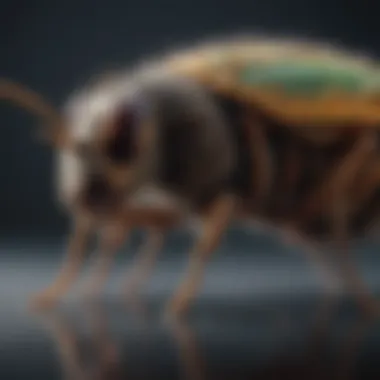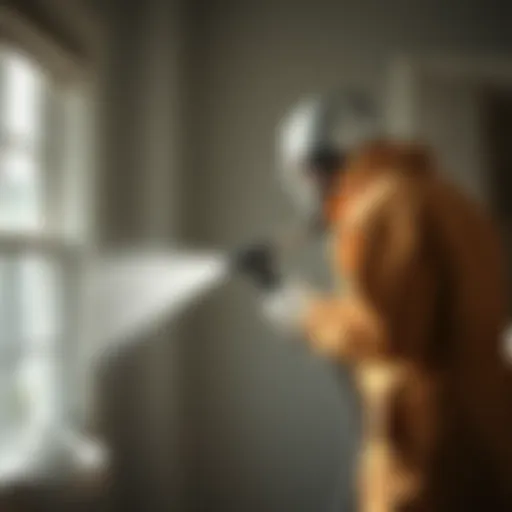Official Pest Control Practices Explained Thoroughly


Intro
Pest control is the unsung hero of maintaining a harmonious household. Many homeowners live in blissful ignorance of the pests that might be lurking in the corners of their kitchens or burrowing into their gardens, yet these small nuisances can wreak havoc if not managed effectively. Understanding the intricacies of official pest control practices not only informs better approaches to pest management but also emphasizes the importance of ecological balance. This guide delves into the various strategies, methods, and regulations that define pest control, providing homeowners with insights to navigate the often murky waters of this vital subject.
Understanding the Pest
Proper pest management starts with a keen understanding of the pests themselves. To successfully repel or eliminate unwanted critters, one must first grasp who they’re dealing with.
Identification
Identification is not merely a formality; it’s the bedrock of effective pest control strategies. Knowing whether you’re facing a common ant, a stealthy cockroach, or detrimental termites can shape how you tackle the issue. A few key identifiers to consider include:
- Physical Characteristics: Size, color, and distinctive features can quickly point you towards the right species.
- Behavior Patterns: Do they swarm, fly, or crawl? Understanding their habits allows for predicting their movements and thus planning a counter-strategy.
- Habitat Preference: A close look at where they’re commonly found, whether in wall cavities or gardens, can inform prevention.
Life Cycle
Every pest undergoes a life cycle that might include eggs, larvae, and adult stages; each requiring a different approach for management. For instance, addressing the larval stage of a pest like the common housefly called Musca domestica necessitates a different strategy than managing its adult form. Understanding these cycles not only aids in timing your control efforts effectively but also highlights potential entry points for future invasions. Knowledge can truly be your best ally.
Pest Prevention Strategies
A stitch in time saves nine, as they say, and pest prevention often proves far more effective than dealing with an infestation later on. Crafting a pest-free environment not only protects your home but also saves on time and money.
Environment Modification
By making changes in your immediate surroundings, you can mitigate the likelihood of pest infestations. Some strategies include:
- Seal Entry Points: Check windows, doors, and even gaps in walls for cracks that pests might exploit.
- Proper Waste Management: Store food in airtight containers and manage trash efficiently to deter scavengers.
- Maintain Cleanliness: A clean environment is less inviting. Regularly clean up food crumbs or spills in your kitchen; pests thrive where food is easily accessible.
Physical Barriers
Sometimes, the simplest solutions are the most effective. Physical barriers can serve as the first line of defense:
- Screens on Windows and Doors: This classic tactic keeps out unwanted visitors.
- Traps and Bait Stations: Strategically placed, these can preemptively catch pests before they establish a foothold in your space.
Control Methods
Even with the best preventive measures, infestations may still occur. At this point, more aggressive control methods may need to be employed.
Chemical Control
Chemical methods are often viewed with skepticism due to their potential environmental dangers. However, when stewardship of the environment is balanced with chemical use, positive outcomes can emerge. Specialized products, designed for specific pests, can provide lasting impacts while preserving the surroundings. Always review the labels and ensure that application methods follow the established guidelines.
Biological Control
An alternative worth exploring is biological control, which employs natural predators or parasites to manage pest populations. For example, certain parasitic wasps can help keep caterpillar numbers in check. This method aligns closely with eco-friendly pest management principles and promotes biodiversity.
"Nature has its own checks and balances, and sometimes it’s best to let her do the heavy lifting".
Understanding Official Pest Control
Understanding official pest control goes beyond simple extermination; it delves into the delicate balance between effective pest management and environmental stewardship. In a world increasingly aware of ecological impacts, this subject is particularly relevant to housewives and homeowners who seek solutions that are not only effective but also sustainable. Official pest control encompasses licensed practices regulated by governmental bodies to ensure safety and standards.
Assessing the importance of such structured pest control is crucial. It provides reassurance that the methods employed are not haphazard but rather are based on scientific principles and legal requirements. Knowledge in this realm lets homeowners make informed decisions, protecting their homes while also considering their impact on the broader ecosystem.
Definition and Scope
When we talk about official pest control, we refer to a system composed of numerous strategies designed to manage a variety of pest issues. These pests can range from common household nuisances like ants and cockroaches to more serious agricultural threats such as locusts and aphids. The scope of official pest control includes identification, prevention, and management facilitated by trained professionals using approved methods.
This regulated framework is vital in ensuring that pest control techniques don’t pose unnecessary risks to human health or the environment. Homeowners are encouraged to seek licensed services that comply with local regulations, ensuring they receive the best possible care and results tailored to their specific situation.
Historical Context
The roots of pest control can be traced back thousands of years to ancient civilizations that sought to protect their crops from various threats. The early Egyptians employed various natural substances to keep pests at bay, indicating an understanding of the pest problem long before today's chemicals and technologies.
Fast forward to the present, the evolution of pest control has been heavily influenced by scientific advancements and growing awareness of environmental challenges. The introduction of pesticides in the mid-20th century revolutionized the field, but also sparked debates about the consequences of chemical use. This led to a gradual shift towards integrated pest management (IPM) techniques that combine biological, cultural, and mechanical practices to manage pest populations sustainably and effectively.
Importance of Regulation
Regulation in pest control is paramount in bridging the gap between effective solutions and safety. Government agencies oversee activities and enforce policies that ensure pest control methods do not adversely affect public health or the environment. These regulations also guide pest control operators in using safe, appropriate techniques and materials.
Well-regulated pest control practices foster public trust and accountability among service providers. Licensed operators are often required to undergo training and continuing education, keeping them updated on the latest research and trends in pest management. This ongoing education helps them make informed decisions in the field, significantly reducing the chances of public health crises and protecting the ecological balance.
"Regulatory frameworks in pest control ensure that the queen bee of pest management operates smoothly, keeping the hive healthy."
This crucial aspect of official pest control ensures that homeowners can engage with service providers like confident customers, knowing that they are receiving care that adheres to required standards. As awareness grows, so too does the expectation for pest control practices to align with sustainable living, emphasizing the need for specialized knowledge and expertise in this field.
Types of Official Pest Control Services
When it comes to managing unwelcome pests, it's not a one-size-fits-all scenario. Different situations require tailored approaches, and that's where Types of Official Pest Control Services come into play. These services are crucial for effectively addressing pest problems, safeguarding health, and maintaining environmental integrity. Let's explore the three primary sectors where pest control services are applied: residential, commercial, and agricultural. Each sector comes with its own set of challenges and solutions.
Residential Pest Control


In the bustling hive of home life, residential pest control is often a necessity rather than a choice. Homeowners face various pest challenges, from the occasional mice scurrying in the attic to unwelcome termites gnawing at the foundation. The importance of residential pest control lies not only in the comfort of living pest-free but also in the health and safety of the family.
Many homeowners often turn a blind eye to minor infestations, thinking they can handle it themselves. However, brief appearances of pests may lead to larger problems down the line. A professional service knows how to conduct thorough inspections to identify hidden issues before they spiral out of control.
Furthermore, treatments and preventive measures not only eliminate existing pests but also safeguard against future invasions. In this maze of pest management, many companies use eco-friendly methods to resolve issues effectively while ensuring the safety of home occupants.
Commercial Pest Management
When pests invade a business, the stakes are high. Commercial pest management requires a distinct level of professionalism and discretion. The impact of pests in commercial settings can be devastating—lost revenue, damaged reputations, regulatory fines. From restaurants to offices, a proper pest control strategy is essential for maintaining operational integrity.
In addition to using more aggressive techniques, like baits and traps, commercial pest control companies often design ongoing management programs that involve regular inspections and preventive protocols. These tailored plans are geared towards specific environments and health regulations that govern food and public safety sectors. The successful pest control strategy not only protects profit margins but also enhances customer trust and staff safety.
Agricultural Practices
In the world of agriculture, pest management is akin to a high-stakes game. Agricultural practices depend heavily on maintaining healthy crops, and pests can be ruthless adversaries. From insects that chew through leaves to diseases that turn once-thriving plants into lifeless husks, farmers must implement effective pest control strategies to safeguard yields.
Employing integrated pest management (IPM) is increasingly common in agriculture. This involves a combination of biological controls (such as predators), cultural practices (like crop rotation), and judicious use of chemical treatments when necessary.
The benefits of robust agricultural pest control go beyond immediate crop protection. Healthy pest management practices can lead to improved food security and higher-quality produce. Plus, in an era where sustainable practices are in high demand, organic pest control methods have emerged, reassuring consumers while maintaining profitability.
Understanding these types of official pest control services not only helps individuals address current pest issues but also paves the way toward proactive management strategies that adequately prepare for future challenges. Through tailored approaches, each sector can maintain its integrity while cultivating a more sustainable environment.
"Prevention is better than cure" is a timeless adage that rings especially true in pest management.
Legislation and Policies
The sphere of pest control is not merely about exterminating undesirable organisms. Rather, it's intricately woven with numerous sets of rules and norms that guide the practices and strategies employed within the industry. The legislations and policies surrounding pest control play a crucial role in ensuring that methods adopted are safe, effective, and environmentally friendly. This segment will unravel the layers of these regulations, emphasizing their significance, benefits, and the vital considerations that home and business owners should be aware of.
Local Ordinances
Local ordinances form the backbone of pest control regulation at a community level. They establish specific guidelines tailored to the regional pest situations. For instance, a town plagued by a recurrent rat infestation may have stringent rules on trash disposal, encouraging residents to use sealed bins to minimize food sources for these pests.
Adhering to local ordinances can offer numerous benefits:
- Safety: By following established protocols, local authorities help mitigate risks associated with indiscriminate pest control measures, which could harm people or pets.
- Community Health: Rigid pest management practices can suppress disease-carrying pests, reducing the risk of outbreaks in the community.
- New Treatments & Alternatives: Some local laws may promote the use of biologically-based pest control methods, steering the community towards more eco-friendly solutions.
National Pest Control Guidelines
On a broader scale, national pest control guidelines inform best practices and industry standards, ensuring uniformity across various states. The Environmental Protection Agency (EPA) in the United States oversees standards that govern chemical applications used for pest control. These regulations require that any pesticides registered for public use undergo rigorous testing for safety and effectiveness before they can be marketed.
Understanding these guidelines is essential for homeowners and professionals alike. It helps:
- Promote Safe Use: Proper application techniques and dangers associated with misuse are outlined in these guidelines, safeguarding the public and the environment.
- Informed Decisions: Knowledge of these regulations empowers individuals to make informed choices about which pest control services to use, avoiding those that don’t adhere to these critical standards.
- Supports Accountability: These guidelines hold pest control operators accountable for their practices, contributing to a culture of transparency and trust in the industry.
International Pest Management Policies
As pest-related issues know no borders, international policies play a vital role in fostering cooperation between nations to combat pests that threaten agriculture and public health globally. Organizations like the Food and Agriculture Organization (FAO) advocate for collaboration among countries in developing sustainable pest management practices.
Such policies can ensure:
- Shared Knowledge: Countries can learn from each other’s successes and failures, adapting strategies that suit their unique environmental conditions and pest profiles.
- Global Standards: Consistent policies aid in establishing global standards for pest control that align with ecological preservation goals.
- Cross-Border Cooperation: Joint efforts often focus on tackling invasive species that may travel across borders, ensuring that communities remain informed and prepared.
Technological Advancements in Pest Control
The landscape of pest control is evolving, much like the pests themselves. The integration of technology into pest management offers a suite of innovative solutions that not only enhance efficacy but also minimize the environmental footprint of these operations. As pest control measures become more sophisticated, understanding these advancements is crucial for homeowners and those tasked with maintaining safe living spaces.
Innovative Tools and Equipment
In the past, pest control often meant reliance on traditional traps or chemical sprays. However, advancements in tools and equipment have revolutionized the game. Now, we have things like smart traps that send alerts when they catch a pest, reducing unnecessary checks. These traps often integrate sensors that can differentiate between various species, targeting only the unwanted guests.
For instance, some pest control devices utilize machine learning capabilities, analyzing pest behavior to determine the most effective intervention. This precision not only increases the chances of catching pests quickly but also limits harm to non-target species, making the process more humane and environmentally friendly.
Data-Driven Pest Management
Data-driven approaches in pest management are gaining traction. By utilizing data analytics, pest control professionals can predict pest outbreaks and tailor their strategies accordingly. This includes mapping infestations geographically, understanding seasonal patterns, and analyzing weather conditions. For example, if there's a forecast of increased moisture in a certain area, pest management services can proactively apply preventative measures to mitigate potential infestations.
Moreover, the use of drones for aerial surveying allows for a comprehensive overview of large properties. Homeowners can monitor for potential pest problems over vast areas without needing frequent ground inspections. The combination of data analytics and technology creates an opportunity to address not just the symptoms but the root causes of pest issues.
Emerging Chemical Solutions
While looking towards the future, the development of emerging chemical solutions cannot be overlooked. Traditional pesticides often come with a host of concerns regarding toxicity and environmental impact. Emerging alternatives focus on creating biopesticides derived from natural substances, reducing risks associated with conventional chemicals. For instance, neem oil and diatomaceous earth are favored for their minimal environmental impact and effectiveness against a broad range of pests.
Additionally, the sector is seeing innovations in targeted delivery systems, where chemicals are released in a controlled manner to minimize exposure and waste. This smart approach not only conserves resources but also ensures a more focused impact on pest populations, making pest control safer for humans, pets, and beneficial insects alike.
"Embracing technology in pest control is not just about catching pests better; it's about creating sustainable practices for future generations."
In sum, technological advancements in pest control pave the way for smarter, safer, and more sustainable practices. This shift not only equips pest control professionals with superior tools but also arms homeowners with the knowledge to make informed decisions about pest management strategies. The implications of these technologies extend beyond immediate pest eradication, touching on broader themes of environmental stewardship and community health. Understanding these advancements is vital for anyone concerned about maintaining a pest-free, eco-conscious home.
Eco-Friendly Pest Control Solutions
In recent times, a shift toward eco-friendly pest control solutions has become crucial. As society grows more aware of environmental issues, homeowners are increasingly demanding strategies that minimize harm to the planet. The importance of this topic cannot be overstated—green approaches not only protect our ecosystems but also promote healthier living conditions within our homes.
One of the core elements of eco-friendly pest control is the use of Biological Control Methods. This approach utilizes natural predators to manage pest populations. For example, introducing ladybugs can help control aphids in gardens, creating a natural balance. This method reduces the need for harmful chemicals, which can leach into the soil and waterways, potentially affecting wildlife and water quality. Utilizing biological control can be a slow process, but it offers a long-term solution that aligns with environmental stewardship.


Biological Control Methods
Biological control involves harnessing the power of nature against pests. Following are some key aspects:
- Natural Predators: Birds, insects, and even certain mammals can help keep pest populations in check.
- Microbial Pesticides: These include beneficial bacteria or fungi that target specific pests, destroying them without harming other organisms.
- Companion Planting: Certain plants repel pests or attract beneficial insects, improving biodiversity in gardens.
By embracing biological control methods, house owners not only reduce reliance on synthetic chemicals but also promote a balanced ecosystem, creating a haven for both plants and wildlife.
Sustainable Practices
Sustainable practices in pest control involve using strategies that have minimal long-term impact on the environment. Here are some common sustainable practices:
- Cultural Practices: Adjusting farming techniques or landscape management can deter pests. For instance, rotating crops can prevent soil depletion and interrupt pest life cycles.
- Targeted Treatments: Utilizing precision technology to apply pesticides only where needed minimizes waste and environmental contamination.
- Composting and Organic Gardening: By using organic waste to create compost, homeowners can enrich the soil health and promote pest resistance in plants.
These practices reduce chemical exposure and foster a more sustainable environment, proving beneficial for human health as well.
Integrative Pest Management (IPM)
Integrative Pest Management embodies a holistic approach, combining various methods to control pest populations effectively while safeguarding the environment. The fundamental principles of IPM include:
- Monitoring: Regular inspections help identify potential pest issues early on, allowing for quick intervention before infestations occur.
- Threshold Levels: Establishing action thresholds ensures that treatment is only initiated when pest levels exceed a specific limit, reducing unnecessary applications.
- Diverse Strategies: IPM incorporates biological, cultural, physical, and chemical control: the right tools for the job at different stages of pest development.
Implementing IPM proves effective and responsible, allowing homeowners to manage pests while maintaining a consciousness toward ecological health.
"Environmentally sound pest management is the backbone of sustainable living."
The Role of Education and Training
Education and training in pest control are the bedrock of effective pest management strategies. The complexities and nuances of dealing with pests—be they rodents, insects, or larger wildlife—demand a well-informed approach. As consumers and property owners become increasingly aware of pest control's environmental impact, the need for knowledgeable professionals becomes paramount. Education shapes the practitioners who safeguard our homes, farms, and businesses from infestations, and ensures that they do so safely and sustainably. Investing in this area is not just about learning the trade; it’s about cultivating an ethos of responsibility and awareness in pest management practices.
Professional Certifications
Professional certifications serve as a benchmark for competence and expertise in the pest control industry. A certified technician is often seen as more credible by clients, demonstrating that they have met specific standards and have up-to-date knowledge of the latest techniques and regulations. Certifications can include training in integrated pest management, chemical safety, and ecological conservation strategies.
Many organizations offer certification programs, such as the National Pest Management Association (NPMA) and various local agencies. Here’s why professional certifications are vital:
- Credibility: Clients feel more secure knowing their pest control expert is certified.
- Knowledge Update: Certification programs often require ongoing education, ensuring professionals stay informed of the latest trends and techniques.
- Regulatory Compliance: Many regions have specific laws necessitating certifications for those who apply pesticides, making it a legal requirement for practitioners.
Obtaining a certification is an investment in one’s career that pays dividends in both professional recognition and client trust.
Public Awareness Campaigns
Public awareness campaigns are crucial for educating the community about pest control options. These campaigns serve several purposes:
- Informed Choices: Residents need to understand the implications of various pest control methods, particularly regarding health and environmental safety. Knowledge empowers homeowners to make informed decisions about the services they seek.
- Misconceptions: Many misconceptions surround pests and their control measures. Campaigns can address common myths, such as the belief that only chemical solutions are effective. They highlight alternative methods, including eco-friendly options.
- Community Involvement: Awareness campaigns often encourage community involvement, promoting local pest control workshops and seminars. This involvement fosters a culture of sustainability, where residents are more conscious of their role in pest management.
"Education is the most powerful weapon which you can use to change the world." - Nelson Mandela
Academic Programs in Pest Management
The educational landscape in pest management is evolving, with universities and colleges developing dedicated programs. These programs often encompass a mix of theoretical knowledge and practical experiences, covering topics such as:
- Entomology: Understanding insect behavior, physiology, and ecology is foundational to pest control.
- Integrated Pest Management (IPM): Academic courses emphasize this holistic approach, combining biological, cultural, and chemical methods of control.
- Pesticide Safety and Regulations: Courses ensure future pest control practitioners are trained in safe application practices and are aware of pertinent regulations.
Colleges and universities often partner with pest control companies for internships, bridging the gap between education and practical service delivery. Graduates enter the workforce not only armed with knowledge but also with hands-on experience that can significantly improve service standards in pest management.
Challenges in Official Pest Control
As the realm of pest control advances, so do the challenges that accompany it. Understanding these hurdles is crucial for anyone involved in pest management, from homeowners seeking solutions to professionals looking for effective strategies. The balance between effective pest control and environmental sustainability takes center stage, requiring innovative thinking and a proactive approach.
Resistance Management
One major issue dominating pest control discussions is resistance management. Pests are remarkably adaptive; they tend to develop resistance against certain chemicals over time due to repeated exposure. This means that what once worked effectively can become less potent or ineffective altogether. For instance, bed bugs and cockroaches have shown resilience to many popular insecticides, leading to increasingly complex eradication efforts.
Households face a daunting situation when they find themselves in the cycle of applying various products, only to see those pests persisting. The key to resistance management lies within a strategic approach. Employing an integrated pest management strategy (IPM) that combines biological, cultural, and chemical methods can help in managing and possibly reversing resistance.
"Understanding how pests adapt is critical to developing a smarter pest management plan."
Public Perception Issues
Public perception plays a significant role in the landscape of pest control. Many homeowners harbor concerns about the chemicals used in pest management, fearing the potential health risks to themselves and their families. This apprehension sometimes leads to a hesitance in calling pest control services, opting instead to try DIY solutions. Such mindsets can create a perfect storm for pest populations to flourish.
Educating the public about the safety of modern pest control practices is vital. Pest control professionals must strive to explain their methods, share the safety measures taken, and provide clear information about new technologies that prioritize human and environmental safety. For instance, eco-friendly products, such as those derived from plant oils, are gaining traction. Homeowners are often more willing to embrace these methods if they clearly understand how they work and their efficacy against common pests.
Budget Constraints
Budget constraints also present a significant challenge. Pest control services can sometimes be viewed as an extra expense rather than a necessary investment. Many families ponder over the immediate costs without taking into account the potential long-term savings that effective pest management can offer.
A pest infestation can lead to structural damage, health problems, and increased repair costs down the line. Therefore, it becomes essential for pest management professionals to communicate the value and benefits of their services effectively. Offering tiered pricing plans or seasonal packages can also make these services more accessible to homeowners, ensuring pest issues are handled promptly rather than allowing them to escalate.
By navigating these challenges, officials within the pest control sector can find a more sustainable path forward, one that aligns with the broader goals of public health and environmental preservation, while also meeting consumer needs.
Case Studies in Pest Control


When delving into the realm of official pest control, case studies offer invaluable insights that go beyond theoretical understanding. They serve as real-world illustrations of what strategies work, what don’t, and why. This subsection not only sheds light on successful pest management programs but also highlights lessons learned from setbacks. Ultimately, such analyses can strengthen the overall pest control approach, providing references for homeowners, pest control operators, and policymakers alike.
Successful Pest Control Programs
Success stories in pest control are often the most illuminating. For instance, a community in Texas faced significant issues with urban rodent populations. The local government initiated a comprehensive pest control program that included regular inspections, public awareness campaigns, and neighborhood clean-up events. As a result, the city saw a dramatic decrease in rodent complaints within just two years.
- Key Elements of Success:
- Community Involvement: The program fostered a sense of shared responsibility among residents, who reported sightings and maintained cleanliness in their areas.
- Regular Monitoring: Ongoing evaluation by local authorities ensured that pests were controlled effectively, adapting strategies as new challenges arose.
- Public Education: Workshops teaching residents about proper waste disposal and signs of infestation empowered individuals to take necessary action.
Lessons Learned from Failures
Not all pest control programs hit the mark, and failures offer lessons that should not be overlooked. A notable example comes from a large-scale agricultural initiative aimed at eradicating locust swarms in Africa. The program faced criticism for its reliance on chemical pesticides, which led to collateral damage to non-target species and resistance issues among locusts.
A few core lessons emerged from this experience:
- Integration of Methods: Sole reliance on one method, particularly chemical, can lead to unforeseen consequences. A more holistic approach incorporating biological and mechanical methods could yield better results.
- Local Knowledge: Ignoring traditional practices used by local farmers hampered the program's effectiveness. Listening to and involving the community could have led to a more nuanced and effective strategy.
Innovative Local Solutions
Local solutions can often provide unique perspectives and effective methods that large-scale operations overlook. A compelling example is a small town in New Jersey, where residents began using essential oils as natural repellents against pests. While traditional methods typically involve harsher chemicals, these residents effectively utilized lavender and tea tree oil as alternatives, showing a marked decline in insect presence.
- Unique Strategies Employed:
- Planting Pest-Repellent Flora: Residents organized community gardens with plants that naturally deter pests, creating a biodiverse environment.
- Educating Neighbors: Workshops were held in community centers to teach other residents about DIY pest control methods using organic ingredients, fostering a collective commitment to pest management that benefitted the entire neighborhood.
"Smart pest control is about working together and embracing the resources around us. Recent successes inspire hope that effective solutions exist at the local level."
By examining case studies, whether they represent triumphs or defeats, we gain a roadmap for refining pest control efforts. Such narratives can significantly empower all stakeholders involved, ensuring that pest management evolves continually in response to both successes and unforeseen challenges.
Stakeholders in Pest Control
Pest control is not just a one-player game; it's a battle involving many key participants, each with their own set of responsibilities and influence. Understanding the stakeholders in pest control helps to grasp the big picture. It emphasizes cooperation, communication, and distinct roles, ensuring that the protocols for managing pests are effective for maintaining both public health and environmental balance.
With various interests at stake, recognizing how these entities operate individually and in tandem is crucial for developing comprehensive pest management strategies that are both sustainable and effective.
Government Agencies
Government bodies play a pivotal role in pest control, establishing the legal framework that guides practices and policies. Typically, these agencies set national and regional guidelines that dictate how pest control should be conducted. More than just rules, these agencies monitor compliance, provide funding for research, and even conduct outreach programs to educate the public. For instance, in many countries, departments of agriculture and environmental protection often collaborate to ensure pest control methods reflect environmental safety and public health priorities.
Key Aspects:
- Legislation Enforcement: Government agencies are responsible for enforcing regulations governing pesticide usage. This includes licensing pest control operators and ensuring they meet safety standards.
- Public Awareness: They often run campaigns to inform the public about safe pest control practices, highlighting the importance of using certified professionals and eco-friendly solutions.
- Research and Development: Agencies may fund research into new pest management techniques or alternatives to conventional pesticides, promoting sustainable practices within the community.
Private Pest Control Operators
Private pest control operators form the backbone of pest management services in residential and commercial settings. These are the individuals directly responsible for executing pest control measures. Their knowledge of local pest behaviors and ecosystem dynamics equips them to tailor solutions that work best for their clientele.
Importance and Responsibilities:
- Customized Solutions: Operators assess individual situations and recommend a personalized mold of pest control, integrating both chemical and non-chemical methods, depending on the issue and the environment.
- Compliance with Regulations: It’s crucial that these operators stay updated with government regulations to ensure all treatments adhere to local and national laws, avoiding legal issues.
- Education and Communication: Beyond simply spraying pesticides, these professionals educate clients on preventive measures, fostering a more informed society about pest control. This encourages homeowners to take an active role in safeguarding their properties.
Non-Governmental Organizations
Non-governmental organizations (NGOs) serve as critical players in pest management, often bridging the gap between the public, governmental agencies, and communities. They focus primarily on promoting sustainable practices and raising awareness about the environmental impact of pest control methods. NGOs often lead charge in advocating for policies that protect both people and the planet.
Roles Played by NGOs:
- Advocacy: NGOs lobby for stricter regulations on harmful pesticides and promote public health initiatives that prioritize preventive measures.
- Education and Training: They conduct workshops, distribute literature, and create online resources aimed at teaching effective pest management strategies that are eco-friendly.
- Community Involvement: NGOs often engage in community projects that aim to reduce human-pest conflicts, illustrating the importance of integrated pest management (IPM) to local audiences.
The collaboration between various stakeholders leads to a more comprehensive strategy, echoing the sentiments that pest control is not just about eradication—it's about cohabitation with the environment.
In sum, the dynamic interplay among government agencies, private operators, and NGOs results in a robust pest control framework that benefits homeowners, businesses, and the ecosystem alike. Understanding the roles of these stakeholders offers invaluable insights into effective pest management strategies.
Future Directions in Pest Control
As the world grapples with escalating pest problems combined with a growing concern for ecological balance, future directions in pest control carry significant weight. Understanding where pest management is headed ensures that homeowners and pest control professionals alike are equipped with the latest tools and knowledge to handle infestations effectively. By examining trends in research and development, potential regulatory changes, and the role of technology, we can gauge how to better address these persistent challenges.
Trends in Research and Development
The landscape of pest control is continuously evolving. Researchers are increasingly focusing on developing sustainable and effective solutions that work in tandem with nature rather than against it. New biological control methods emphasize integrating natural predators into pest management practices. This not only reduces reliance on harsh chemicals but also helps maintain the ecological balance.
Recent advancements have also highlighted gene-editing techniques, such as CRISPR, which open doors to more targeted pest-resistant crops. These methods promise to disrupt pest reproduction cycles without affecting beneficial organisms. Additionally, studies into user-friendly traps and effective baits are on the rise, allowing homeowners to address pest issues with minimal hassle.
"Effective pest control of the future must blend sustainability with efficacy, ensuring that what we use is both effective and safe for our environment."
Potential Changes in Regulations
Legislative frameworks surrounding pest control are likely to evolve as public concern about health and safety grows. With mounting evidence linking pesticides to various health issues, authorities are under pressure to tighten regulations. For homeowners, this means that familiar products might become restricted or require special training for use.
As organic standards become more widely recognized, the demand for environmentally friendly practices can influence legislation. This shift could lead to an emergence of certification programs or guidelines that stress the importance of non-chemical measures. Therefore, keeping abreast of these legislative developments is crucial for homeowners who want to ensure their methods comply with the latest standards.
The Role of Technology
Technology plays a pivotal role in shaping the future of pest control. The integration of smart technology into pest management systems is becoming increasingly commonplace. For instance, IoT devices now allow homeowners to monitor pest activity in real time, providing valuable data that can influence control strategies. These insights enable more timely and effective measures.
Remote monitoring systems, coupled with automated traps, reduce the need for constant human intervention. Furthermore, advances in artificial intelligence can analyze pest behavior patterns, leading to more tailored and effective pest control strategies.
The convenience and efficiency offered by these technologies make them attractive options for housewives and homeowners aiming to keep their living spaces safe and comfortable. Embracing these innovations could potentially revolutionize how pest control is implemented in homes across the globe.







